In terms of ease of cultivation, marigolds simply have no equal. This flower is like a wand - it can be planted anywhere. It is drought-resistant, so it grows well in any container, is relatively shade-tolerant and is quite suitable for semi-shady places.
Marigolds are great for growing in borders and can be used to fill any empty spaces in flower beds, for example after digging up spring bulbs.
There are three main types of these flowers: thin-leaved marigolds, rejected marigolds, erect marigolds.
Marigold thin-leaved
Marigolds are thin-leaved annual, compact, low plants (20 - 40 cm). They have dense, small foliage and many non-double small inflorescences (1.5 - 3 cm in diameter), mostly yellow or orange. These plants are great for borders, but can also be grown in mixed plantings. They bloom very profusely, but bloom a little later than other species.
Marigolds rejected
Rejected marigolds do not grow tall (from 15 to 45 cm), the color of the flowers is from red-brown to yellow, the size of the inflorescences is 4-6 cm. The bushes branch well and bloom profusely; one bush can contain up to a hundred inflorescences.
Extremely resilient, unpretentious flowers, but heat-loving. The slightest frost can destroy early-planted seedlings.
Dwarf varieties can be used for growing on hills, in borders, as well as for planting in beds with vegetables or strawberries. Marigold leaves emit a smell that disorients and repels pests.
Flower petals are added to cucumber and tomato brines, after which they acquire a piquant taste and a beautiful golden color.
Marigolds erect
Various varieties of erect marigolds have a height from 45 cm to 130 cm. The size of the inflorescences is 6 - 12 cm, the color of the inflorescences is predominantly yellow. Blooms from late June - early July.
The smell of this variety is less pungent and can be used for cutting. They are grown in flowerbeds, in separate clumps, mixborders or ridges.
Planting marigolds for seedlings
There are three ways to sow seeds:
- In March, in seedling boxes on the windowsill.
- In early May, in a film greenhouse.
- At the end of May in open ground.
The strongest and most viable seedlings are obtained with the second option. But if you can’t wait to start admiring the blooming marigolds, then sow the seeds in early March on the windowsill. Growing seedlings the matter is not at all difficult and will not take you much time.
If you have a lot of space, you can immediately put the seeds into cups and then later you won’t have to pick up the grown seedlings. If there is little space (and most often this is the case), it is better to first sow the seeds in a box or some kind of bowl, and then pick the seedlings into cups.
Soil for growing seedlings. The following soil is suitable for planting marigold seedlings: peat, forest soil, humus and sand, mixed in equal proportions. This does not mean that the substrate should be exactly like this, the main thing is that the soil is light, moisture-absorbing and nutritious.
Soil for growing seedlings is also sold in stores, but both the purchased substrate and the one you prepare yourself must be disinfected in some way. The easiest way is to keep it in the cold in winter, at least 10 - 15 days.
Sowing seeds followed by picking. It is very convenient to plant marigold seedlings in small plastic containers. Make drainage holes in the bottom of such a container and fill it with moistened soil. Level the ground and scatter the seeds evenly.
The germination rate of marigold seeds is very good, so you should not sow thickly. Cover the seeds with a thin layer of soil (no more than 1 cm) and moisten it thoroughly by spraying. Cover the container with a lid or film and place in a warm place.
Planting marigold seeds without picking. If you immediately plant the seeds very rarely (at a distance of 5 - 6 cm.from each other), then picking is not required. It is convenient to plant directly into cups or palettes. To ensure guaranteed germination, the seeds are soaked and germinated before planting.
To do this, the seeds are first laid out on a damp cloth on a saucer, covered with film and placed in a warm place. After 2 - 3 days, the seeds will hatch and then they are placed in cups, where they are also sprinkled with a thin layer of earth.
Seedling care
All types of marigolds are unpretentious plants, but still the easiest to care for are rejected marigolds. Of this entire family, only thin-leaved marigolds are somewhat more finicky.
When the first sprouts appear, and this happens 4-8 days after sowing the seeds, the seedlings are transferred to a bright, cool place. Most often this place is a window sill.
Temperature. For seed germination, it is advisable to maintain a temperature of 24 - 25 degrees. After the emergence of seedlings, it must be immediately reduced and further cultivation should be carried out at +18 - 20 * C.
Watering the seedlings. Until the seeds have sprouted, the soil should be regularly sprayed with dewdrops. Subsequently, the seedlings are watered at the roots, without waterlogging the soil. The soil should dry out before the next watering.
Picking. If the seedlings have sprouted thickly, then after a while they need to be planted into cups or at least planted less frequently. Typically, picking begins when the seedlings have their first pair of true leaves.
When growing marigold seedlings, picking can be done a little later, when the plants already have 2 - 3 pairs of true leaves. Usually seedlings do not stretch, but if this does happen, then when diving they can be planted deeper than they grew before.
Planting seedlings in open ground. For all their advantages, marigolds still have one drawback - even a light frost can destroy them. Therefore, you should not rush to plant these flowers in flower beds while there is a threat of return frosts.
Plants are planted in the ground according to the following scheme: tall varieties 40 × 40 cm, medium varieties 30 × 30 cm and low varieties 20 × 20 cm.
Growing marigolds in open ground
Where and when to sow. Many gardeners do not grow marigold seedlings indoors, but immediately sow them in early May under a film directly in the garden. By the end of May, the seedlings turn into strong and strong seedlings, which can then be planted anywhere.
Marigolds tolerate transplantation well at any age, quickly restoring even a severely damaged root system. If you have little time in the spring, you can sow them even before winter. Only next spring, with the onset of warm days, is it better to cover the sowing site, since frosts can destroy the seedlings.
Growing rules
The soil. They are not picky about soil and can grow on almost any soil.
Location. Marigolds show themselves in all their glory when grown in a sunny place, but they also tolerate planting in partial shade.
Watering. Although these are drought-resistant flowers, you should not overuse them. If there is insufficient watering, the plants will be puny and the flowers small. Watering is most necessary in the first half of the growing season.
Feeding. To grow marigolds, fertilizing is not necessary. After applying nitrogen fertilizers, the plants may begin to “fatten”; there will be few flowers, but a lot of greenery.
Pests. The main pest of marigolds is spider mite. If your flowers look like the ones in the photo above, then they urgently need to be treated with intavir or actar. You can use drugs of non-chemical, biological action such as fitoverm in ampoules.
The most unpretentious flowers: beautiful and useful, video:
Varieties of marigolds rejected.
‘Gold Ball’ (‘Gold Ball’) - Spreading bushes, 50-60 cm tall, highly branched. The shoots are strong, green, with a reddish-brown bloom, ribbed. Leaves are medium sized, green. Inflorescences are simple and semi-double, 4-5 cm in diameter. Reed flowers are arranged in 1-2 rows, reddish-brown, velvety. The tubular flowers are golden yellow. Early variety. Blooms from early June until frost. Good for cutting.
Gold Cophen' (‘Gold Kopchen’) - Compact bushes, 20-25 cm tall, densely leafy. The shoots are strong, green, with a reddish coating. The leaves are medium sized, dark green. The inflorescences are chrysanthemum-shaped, double, 3.5-4 cm in diameter, consisting of golden-yellow, wide-funnel tubular flowers and one row of dark red reed flowers, bent downwards, with a slightly wavy edge. Early variety. Blooms from early June until frost. Recommended for flower beds, ridges, potted plants and decorating balconies.
‘Orangeflamme' (‘Orangeflamme’) - Bushes up to 20-30 cm tall, compact, densely leafy. The shoots are strong, green with reddish stripes. The leaves are dark green with small narrow-lanceolate lobes. The inflorescences are chrysanthemum-shaped, double, 3.5-4.5 cm in diameter, consisting of broad-funneled bright orange tubular flowers with red strokes and one row of reed-like, bent downward red-brown, velvety flowers with a yellow spot at the base and a yellow border. Early variety.Blooms from early June until frost.
Varieties of erect marigolds
Golddicht' (‘Goldlicht’) - Compact bushes, 60-75 cm tall. The shoots are strong, ribbed, light green with a reddish coating. The leaves are large, dark green. Inflorescences are carnation-colored, hemispherical, double, 8-10 cm in diameter. Reed flowers are bright orange. Tubular flowers narrowly funneled, few in number. Late variety. Blooms from late June until frost.
Sonnenschein (Sonnenschein) – a standard-shaped bush up to 50 cm tall with strong, ribbed, green shoots and large green leaves. The inflorescences are chrysanthemum-shaped, 5-6 cm in diameter, golden-yellow in color, consisting of numerous tubular, large flowers with corolla blades twisted downward.
Varieties of thin-leaved marigolds.
‘Golden Ring‘ (‘Golden Ring’) - Bush 40-50 cm tall, compact, spherical, densely branched. The shoots are thin, fragile, light green. The leaves are small, dissected into narrow lobes. The inflorescences are small, 2.5-3 cm in diameter, simple, reed flowers are bent, bright yellow, tubular flowers are small, orange with brown dots on the edges of the corolla lobes. Early variety. Blooms from early June until frost. Recommended for ridges and high borders.
Lemon Jam' (‘Lemon Gem’) - Bushes 28-34 cm tall, spherical in shape. The plants are very branched and bloom profusely. The inflorescences are light yellow with a lemon tint.
Watch a video about the beneficial properties of marigolds. It turns out that they improve vision, treat the pancreas, liver, psoriasis:
And in this video they show how best to design a flowerbed with marigolds:
Continuation of the topic:
- How to grow snapdragons correctly
- Growing garden balsam
- Salvia - variety selection, planting and care
- Growing gatsaniya from seeds
- All about roses
- Description and photos of different varieties of marigolds




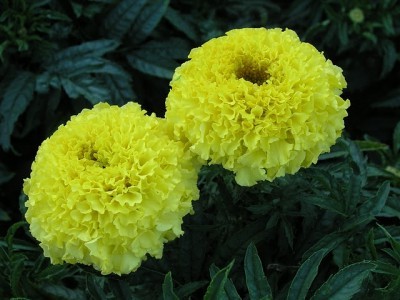
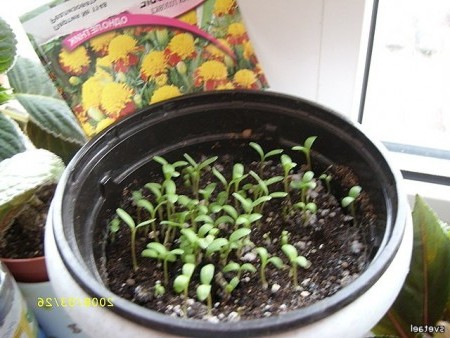
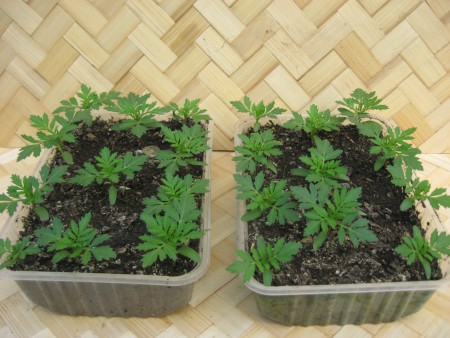
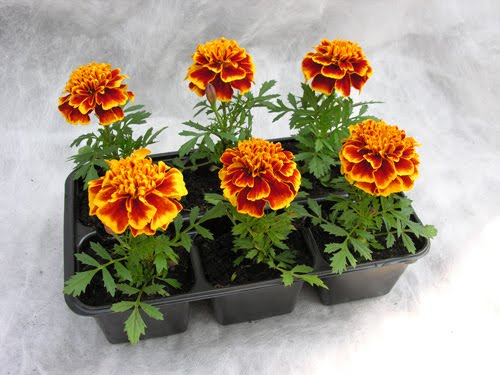
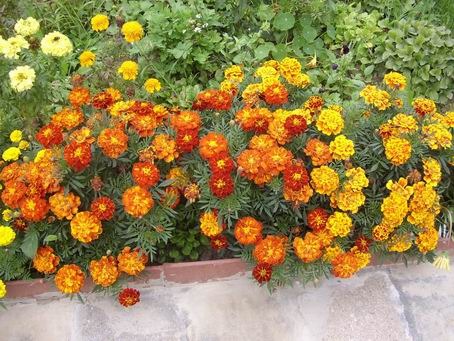
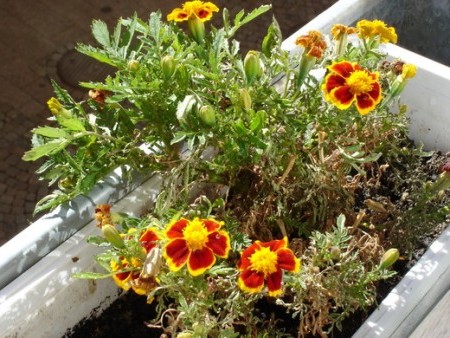
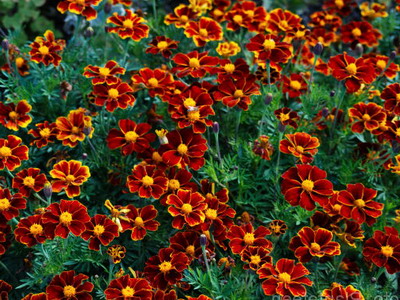
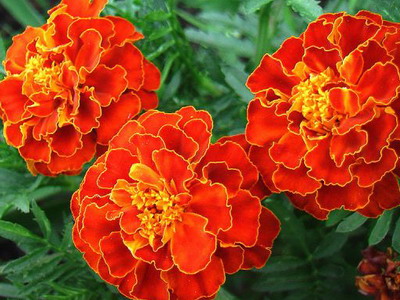

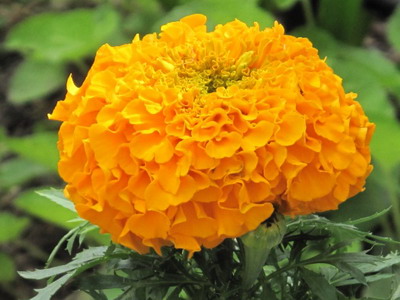

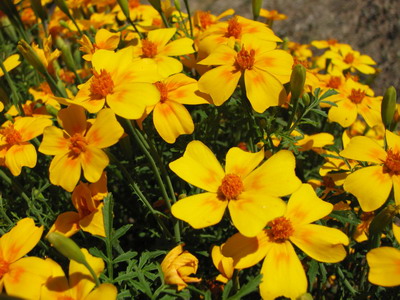
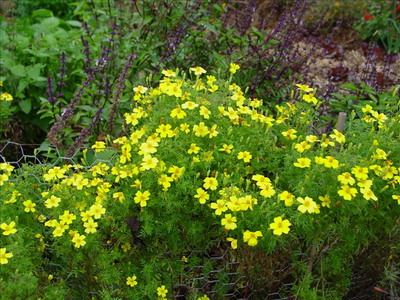

 CUCUMBERS NEVER GET SICK, I'VE BEEN USING ONLY THIS FOR 40 YEARS! I SHARE A SECRET WITH YOU, CUCUMBERS ARE LIKE THE PICTURE!
CUCUMBERS NEVER GET SICK, I'VE BEEN USING ONLY THIS FOR 40 YEARS! I SHARE A SECRET WITH YOU, CUCUMBERS ARE LIKE THE PICTURE! You can dig a bucket of potatoes from each bush. Do you think these are fairy tales? Watch the video
You can dig a bucket of potatoes from each bush. Do you think these are fairy tales? Watch the video
 How our fellow gardeners work in Korea. There is a lot to learn and just fun to watch.
How our fellow gardeners work in Korea. There is a lot to learn and just fun to watch. Eye trainer. The author claims that with daily viewing, vision is restored. They don't charge money for views.
Eye trainer. The author claims that with daily viewing, vision is restored. They don't charge money for views. A 3-ingredient cake recipe in 30 minutes is better than Napoleon. Simple and very tasty.
A 3-ingredient cake recipe in 30 minutes is better than Napoleon. Simple and very tasty. Therapeutic exercises for cervical osteochondrosis. A complete set of exercises.
Therapeutic exercises for cervical osteochondrosis. A complete set of exercises. Which indoor plants match your zodiac sign?
Which indoor plants match your zodiac sign? What about them? Excursion to German dachas.
What about them? Excursion to German dachas.
Interested in the question of how to lower the temperature in the room? The heat in our house is unrealistically high, the window sills are narrow, and the temperature on them is still not the right one, should we keep the windows open?
I fenced off the window opening with plastic film, and cover the radiator with some kind of blanket. The film can be glued to the frame at the top with tape or attached to baguettes. Helps.
Good afternoon I love marigolds very much, but my seedlings never worked out. Now I understand why. I found a very good and simple article about growing marigolds; last year was my first year with my own seedlings. I will do the same this year.
Ah, Lena, Lena... Okay, I'll leave your link.